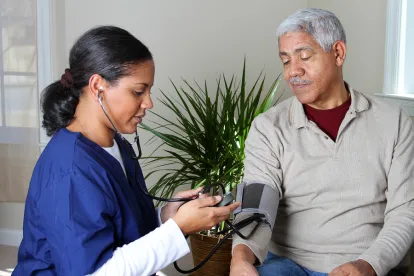In two recent companion cases, Andryeyeva v. New York Health Care, Inc. and Moreno v. Future Care Health Services, Inc., the New York Court of Appeals upheld the New York State Department of Labor’s (NYSDOL) 13-hour rule for the payment of home health aides working 24-hour shifts. Under this rule, an employer may pay home health aides for only 13 hours of a 24-hour shift if the aides receive at least 3 hours of meal break time and at least 8 hours of sleep (at least 5 of which must be uninterrupted).
Regulatory Background
Since 1972, home health aides have been subject to the NYSDOL’s Minimum Wage Order Number 11 for Miscellaneous Industries and Occupations:
The minimum wage shall be paid for the time an employee is permitted to work, or is required to be available for work at a place prescribed by the employer, and shall include time spent in traveling to the extent that such traveling is part of the duties of the employee. However, a residential employee—one who lives on the premises of the employer—shall not be deemed to be permitted to work or required to be available for work:
(1) during [the employee’s] normal sleeping hours solely because [the employee] is required to be on call during such hours; or
(2) at any other time when [the employee] is free to leave the place of employment. (Emphasis added.)
On March 11, 2010, the NYSDOL opined that
live-in employees must be paid not less than for thirteen hours per twenty-four hour period provided that they are afforded at least eight hours for sleep and actually receive five hours of uninterrupted sleep, and that they are afforded three hours for meals. If an aide does not receive five hours of uninterrupted sleep, the eight-hour sleep period exclusion is not applicable and the employee must be paid for all eight hours. Similarly, if the aide is not actually afforded three work-free hours for meals, the three-hour meal period exclusion is not applicable. (Emphasis added.)
Significantly, the NYSDOL explained that the term “live-in” includes both residential and nonresidential employees, so long as they are working a 24-hour shift in a patient’s home. Consistent with this and previous NYSDOL interpretive guidance, many home health care providers have compensated live-in home health aides for 13 hours of 24-hour shifts.
Procedural History
After the NYSDOL issued the March 2010 opinion letter, current and former live-in home health aides challenged the 13-hour rule in multiple putative class actions. These plaintiffs asserted that the practice of failing to pay for each hour of a 24-hour shift was unlawful and provided a basis for class certification. The home health care providers relied upon the NYSDOL’s interpretive guidance to argue that this practice was lawful.
The First Department and Second Department of the Appellate Division of the New York State Supreme Court agreed with the plaintiffs that the NYSDOL’s interpretive guidance conflicted with the plain meaning of the wage order because home health aides are not “residential employees.” As such, the courts concluded that home health aides were entitled to be paid at least the minimum wage for every hour of a 24-hour shift even if they were afforded sleep and meal breaks.
Court of Appeals Decision
The Court of Appeals reversed the First Department and Second Department decisions because it found that the NYSDOL’s interpretive guidance was neither irrational nor unreasonable and, thus, entitled to deference.
In reaching this conclusion, the Court of Appeals stressed that it was required to “defer to an administrative agency’s rational interpretation of its own regulations in its area of expertise,” especially when, as was the case here, that interpretation had been followed for a long time and “reflect[ed] an enduring body of informed administrative analysis.” Although the March 2010 opinion letter was the most recent official NYSDOL statement on the topic, the NYSDOL had published several other guidance documents that were consistent with that opinion letter.
Instead of focusing on the residential/nonresidential dichotomy at the center of the lower appellate courts’ decisions, the Court of Appeals directed its attention to a different phrase in the wage order: “or is required to be available for work at a place prescribed by the employer.” It found that the NYSDOL’s guidance was not inconsistent with this phrase nor an irrational or unreasonable construction of the wage order. Rather, the court held that the NYSDOL had reasonably concluded that the 11-hour period constitutes substantial assignment-free personal time excluded from the time when an employee is “required to be available for work at a place prescribed by the employer.”
The Court of Appeals remanded the cases to the lower appellate courts to evaluate the merits of class certification in light of its ruling deferring to the NYSDOL’s interpretive guidance.
Conclusion
The Andryeyeva/Moreno decision is a significant victory for home health care industry employers. But although the ruling eliminates the possibility that adherence to the 13-hour rule will provide a basis for class certification, it is possible that the plaintiffs could provide evidence of an alternative policy or practice to support certification. Additionally, employers may want to remain vigilant and ensure compliance with the strict requirements of the 13-hour rule. The Court of Appeals reminded employers that these requirements are “hair trigger” and that noncompliance “immediately makes the employer liable for paying every hour of the 24-hour shift, not just the actual hours worked.”




 />i
/>i
